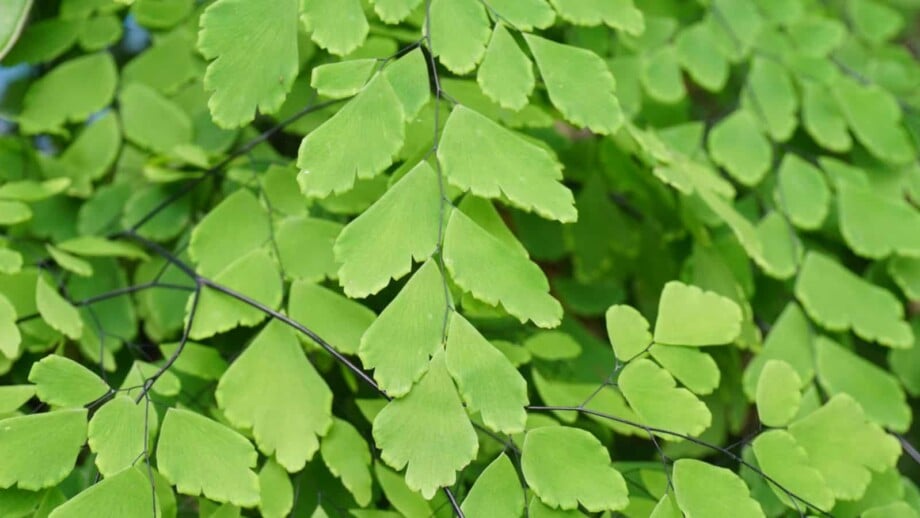Are you just as captivated by the exquisite beauty of maidenhair ferns as I am, yet find yourself at war with maintaining their health? I’ve walked a mile in those shoes!
The maidenhair fern is not your typical plant; it’s got these delicate, fan-shaped leaves and has been around for ages, like way back when dinosaurs roamed the Earth. This article will delve into what draws people to this fern and why it has captivated people for so long.
This guide was born after diving elbow-deep into potting soil research and perfecting that delicate balance of light conditions. A complete roadmap to nurturing your majestic Adiantum raddianum, more fondly known as the maidenhair fern, until no leaf under your gaze ever wilts again! Let’s unveil the secret to keeping these ferns lush with vitality and charisma.
Overview of Maidenhair Fern
Maidenhair Fern, scientifically known as the Adiantum genus, is a captivating plant native to North America. Its delicate leaves and fan-shaped leaflets make it famous for shade gardens and indoor settings. In this section, we’ll explore the key characteristics of the Maidenhair Fern, including its natural habitat.
Maidenhair Fern: Natural Habitat
The Maidenhair Fern, belonging to the Adiantum genus, graces the shaded and damp corners of its native habitats in North America. Its preferred environments are often tucked away in serene and moist locations, such as alongside waterfalls, streams, or lush tropical regions.
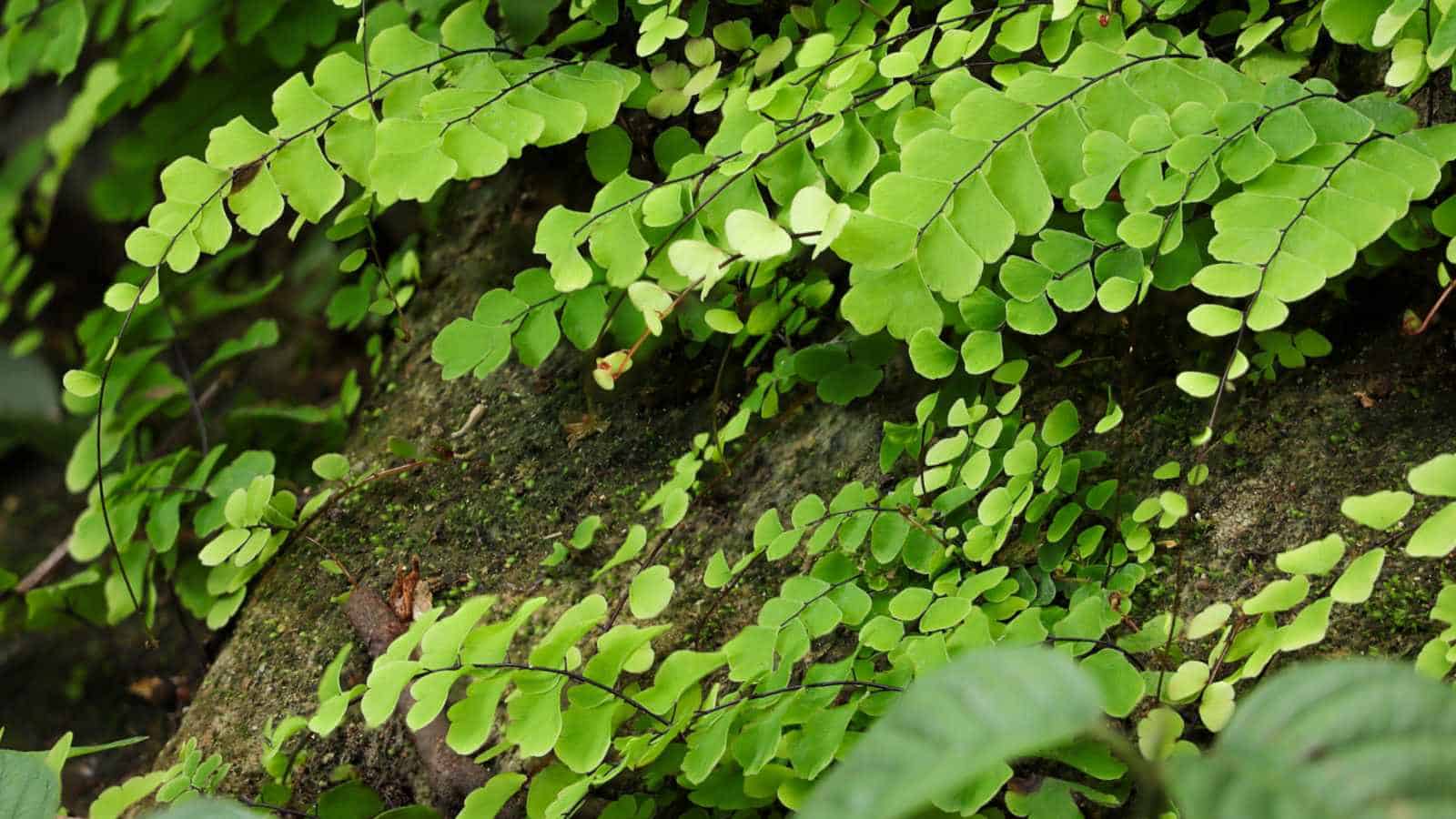
These habitats provide the ideal conditions for the Maidenhair Fern to thrive. These areas’ ample moisture and high humidity offer a nurturing environment for the fern’s delicate fronds. In the wild, you may encounter this species adorning rock crevices or growing along the banks of water bodies, creating picturesque scenes of natural beauty.
Understanding the fern’s natural habitat is crucial for cultivating it in gardens and indoors. Gardeners and enthusiasts can replicate these conditions to ensure the fern’s well-being, striving to mimic the gentle balance of moisture, shade, and humidity it encounters in the wild.
Yet, much like precious gems that require special care and attention, these houseplants can indeed be daunting to cater to. Fret not, though – this comprehensive guide is your toolkit, unpacking tricks and tips about nurturing these lovely indoor companions – from understanding their growth conditions to deciphering common problems they face.
Are you ready to take your green thumb prowess up a notch? Come on then, let’s plunge right into it!
How to Grow and Care for Maidenhair Fern Indoors
Cultivating and maintaining the delicate beauty of Maidenhair Fern indoors requires understanding its light, soil, water, temperature, and humidity preferences. The light should be primarily indirect or dappled for these ferns to thrive.
Soil for Maidenhair fern must be consistently moist and well-drained – neutrality or slight acidity on pH scales works just fine! Water only around the base to avoid wetting leaves, as soggy fronds can speed up rot or fungal diseases in your plant.

Ideal indoor temperatures range from 60-80 degrees Fahrenheit, along with partial shade; amping up humidity levels through regular misting contributes significantly to a thriving Adiantum raddianum environment.
When it comes to fertilizers, use a balanced diluted blend high in Nitrogen every couple of months during growing seasons – this ensures robust health and bright green foliage for your beautiful houseplant.
Light Requirements
Maidenhair ferns thrive best in diffused, indirect light, making them an excellent choice for shaded locations. Avoid placing these delicate houseplants near south or west-facing windows, as direct sunlight can cause leaf burn.
The spaces behind curtains or blinds often provide the proper brightness without exposing the plant to harsh rays.
It’s essential to consider the intensity and duration of light exposure your Maidenhair receives daily. The longer night winter months may require supplementary lighting for your indoor garden; a soft artificial grow light can help maintain growth rates and vibrant foliage coloration during this dormant season.
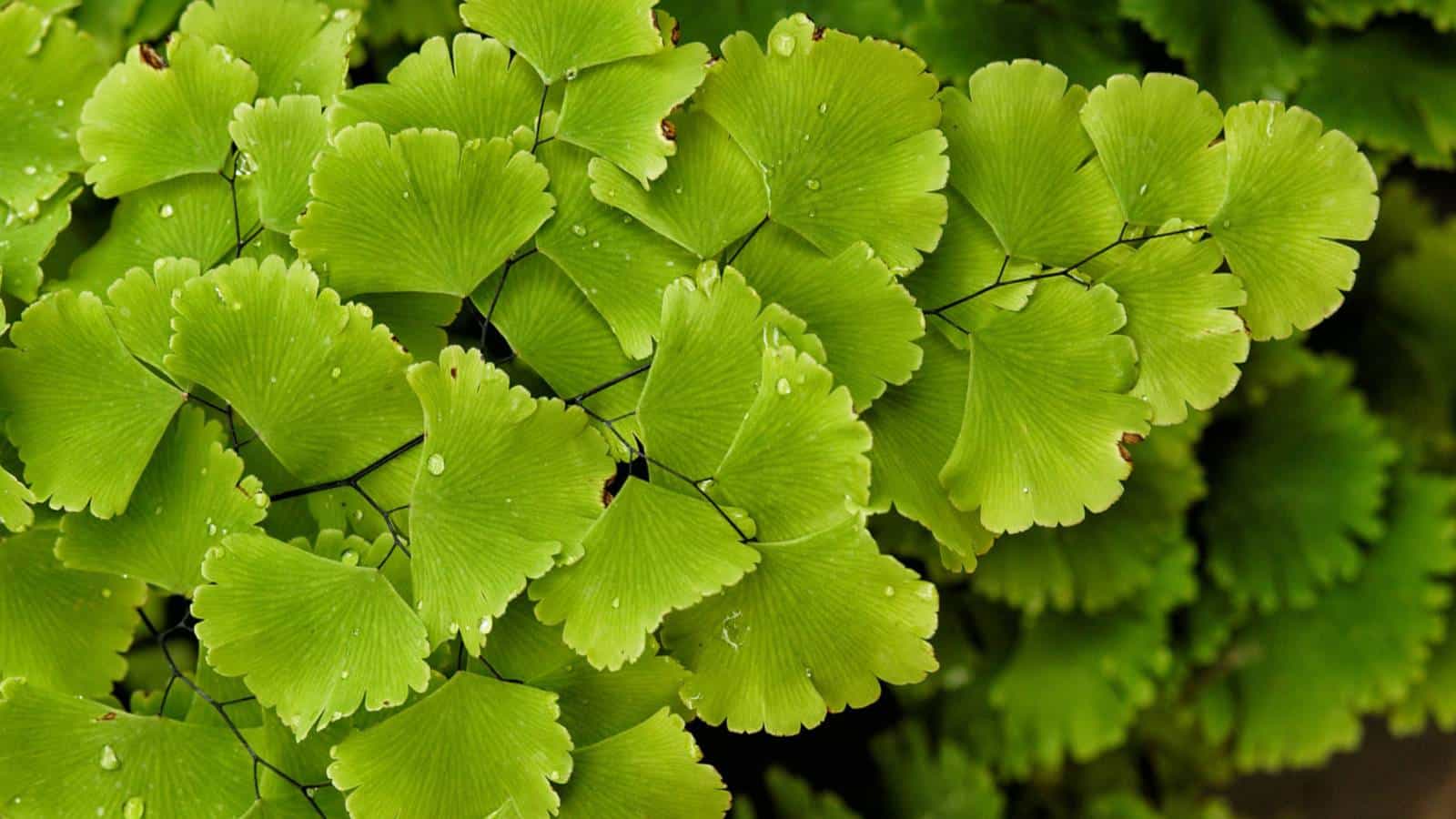
While natural sun exposure is preferred, remember that consistent indirect light watering could lead your Adiantum raddianum towards its mature size splendidly.
Soil Preferences
Maidenhair ferns have particular soil preferences to ensure healthy growth. They thrive in moist but well-drained potting soil. Care should be taken to maintain the moisture level; it should remain consistently wet, not soggy or overly dry.
The neutral pH of this soil provides a hospitable environment, encouraging robust plant life. Regularly applying balanced and diluted fertilizer can supplement natural soil nutrients but is optional for these resilient plants.
Keeping them in nourishing conditions supports an optimal habitat for Adiantum raddianum, better known as Maidenhair ferns.
Ideal Watering Practices
Keeping your Maidenhair Fern hydrated involves a specific watering routine. Here is a step-by-step guide to ensuring proper moisture while preventing root rot:
- Always keep the soil of the plant slightly moist.
- Water the plant thoroughly, but avoid waterlogging to prevent root rot.
- Ensure your plant pot has enough drainage holes for excess water to trickle out quickly.
- Rather than following a strict watering schedule, check the top inch of soil before watering; if it feels dry, it’s time to water.
- Avoid watering with cold water; room temperature is best to avoid shocking the plant.
- Invest in a humidity tray or pebbles and fill it with water; place your pot on top for increased humidity without direct contact between roots and water.
- Place your fern near a humidifier or in a bathroom that gets steamy showers for additional ambient moisture.
Optimum Temperature and Humidity
Maidenhair ferns thrive best in warm, humid conditions. Indoor temperatures ideally should stay above 60 degrees Fahrenheit for these moisture-loving plants. They greatly appreciate humidity levels around 50% or higher.

In less humid environments, I maintain the desired humidity level by placing my maidenhair fern on a tray filled with pebbles and adding water just below the upper surface of the stones.
This creates a mini ‘humidity dome’ that provides the necessary moistness to keep your plant lush and healthy.
The Role of Fertilizer
Fertilizer is essential in nurturing the growth and health of Maidenhair ferns. Its role is particularly relevant to species such as Delta maidenhair and rosy maidenhair fern, which thrive with regular fertilization.
It’s essential to do what is necessary; applying a balanced houseplant fertilizer once a month will suffice for these slow-growing ferns.
The best soil type for this routine would be moist, well-drained soil with a neutral pH. This balance ensures that the nutrients from the fertilizer are evenly distributed while averting complications like root rot or nutrient burn.
Despite its benefits, remember that Maidenhair ferns can survive without fertilization—a testament to their resilience.
3 Essential Tips for Growing Maidenhair Ferns in Shade Gardens
If you’re eager to introduce the mesmerizing beauty of Maidenhair Fern into your garden, this section is your gateway to success. Here, we will unravel the essential care tips necessary to create an ideal environment for this enchanting fern. From understanding the importance of shade to managing soil moisture and humidity, we’ll cover all the key aspects to ensure your Maidenhair Fern thrives.
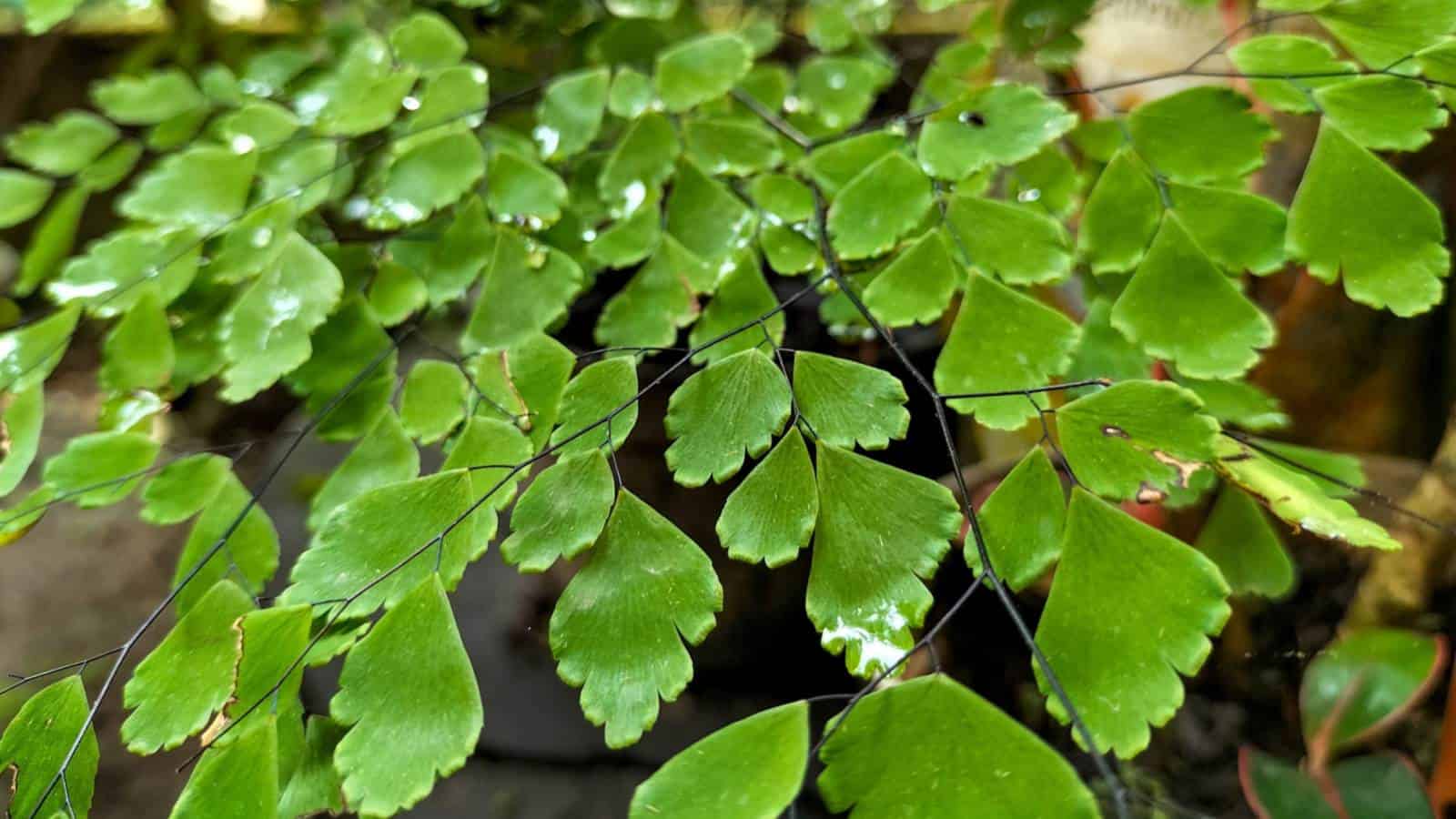
-
Embracing Shade
One of the defining characteristics of Maidenhair Fern is its preference for shade. In the wild, it naturally thrives in the dappled sunlight beneath the canopy of trees or near water bodies. When cultivating this fern in your garden, it’s crucial to mimic these conditions by selecting a shaded location.
Avoid exposing it to direct sunlight, which can scorch its delicate fronds. Partial to full shade areas, such as beneath taller plants or along the north side of your garden, provide the ideal setting for your Maidenhair Fern to flourish.
-
Soil Moisture and Humidity
Maidenhair Ferns are notoriously picky when it comes to soil moisture and humidity. These plants demand consistently moist soil, but not waterlogged, as they are sensitive to under-watering and overwatering.
To achieve the right balance, choose well-draining soil rich in organic matter. Regularly check the soil’s moisture level and water the fern whenever the top inch of soil feels dry. Moreover, maintaining humidity levels around the plant is vital for its health. Consider misting the fronds or placing a tray of water nearby to create a humid microclimate.
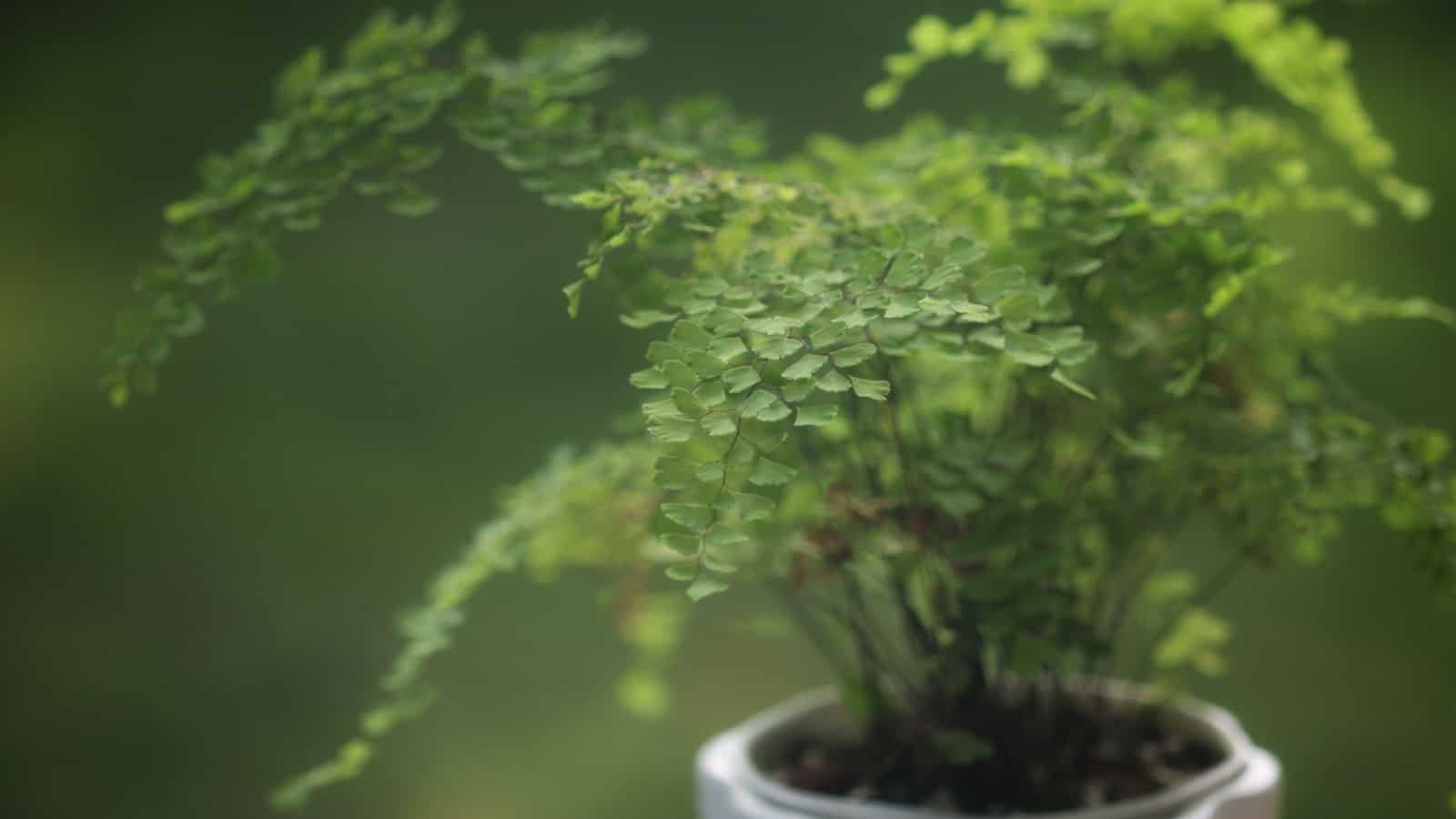
-
Compost and Rainwater
Consider incorporating compost into the soil to provide your Maidenhair Fern with the nutrients it needs. Compost enriches the soil with organic matter, enhancing its texture and fertility. This can be especially beneficial for ferns planted in garden beds.
Additionally, rainwater is an excellent choice for watering your fern. It’s naturally soft and lacks the chemicals often found in tap water, which can harm the fern’s sensitive roots and fronds. Collect rainwater in a barrel or container and use it to keep your fern consistently moist.
By implementing these essential care tips, you can create an environment that mirrors the Maidenhair Fern’s natural habitat, allowing it to thrive and reveal its captivating beauty in your garden.
4 Types of Maidenhair Fern
There are various types of maidenhair ferns. Let’s explore a few notable ones, like the Delta Maidenhair Fern, known for its triangular leaves and curvy edges. The American Maidenhair Fern displays unique fan-shaped leaf segments on wiry black stems.
The Northern Maidenhair Fern, or Adiantum pedatum, is beautiful with its lofty arching fronds, while the Southern Maidenhair Fern (Adiantum capillus-veneris) captures hearts with finely textured luminous foliage.
Each type brings distinct characteristics to your indoor garden, with delicate beauty being their common trait.
1. Delta Maidenhair Fern
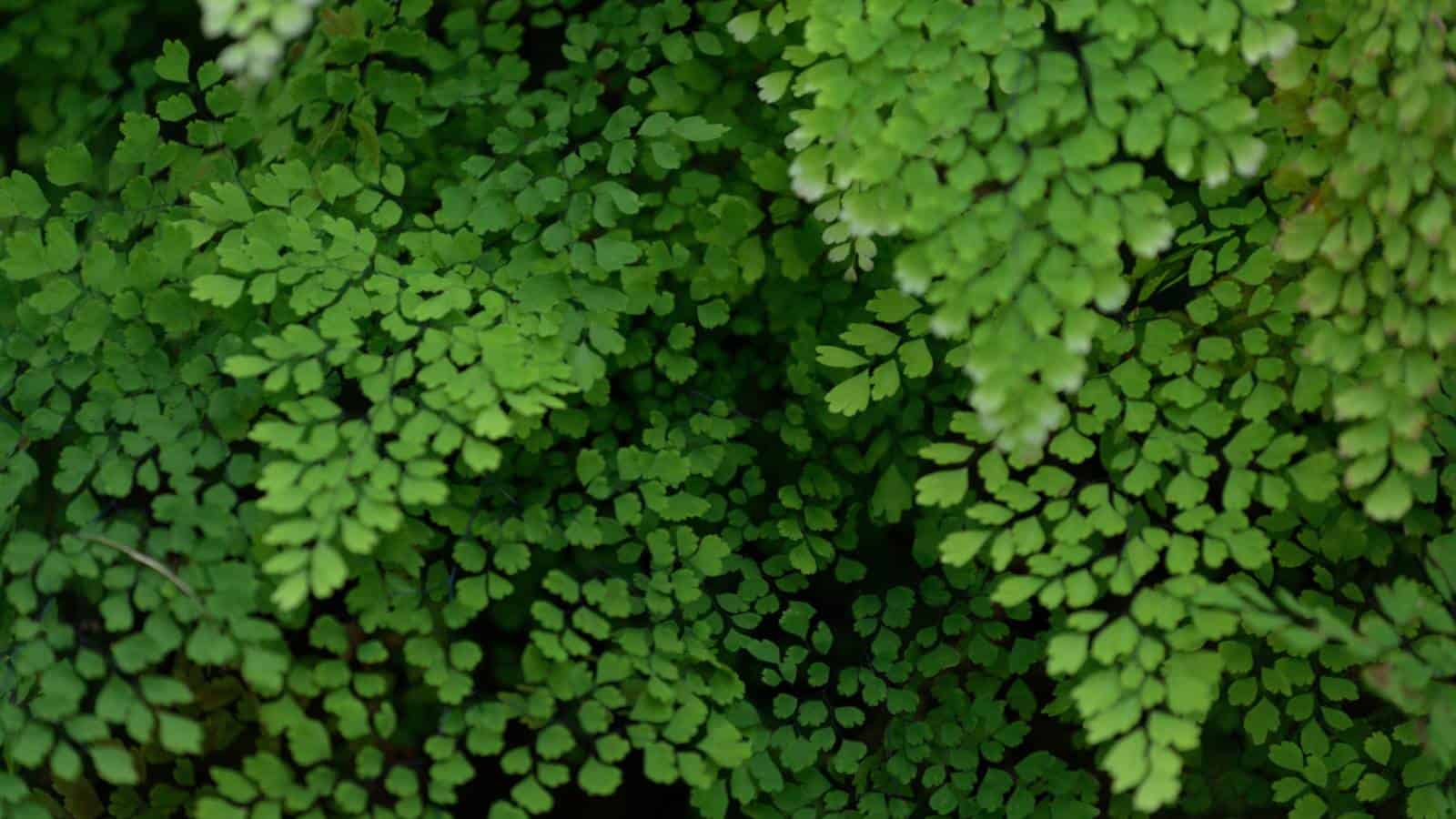
The Delta Maidenhair Fern, also known as Adiantum raddianum, has won the hearts of many plant lovers with its unique charm. This fern displays delicate, fan-shaped leaf segments that hang elegantly on wiry black stems.
Some say it gives an impression of a soft green waterfall cascading over the side of its pot. The Adiantum raddianum thrives in bright, indirect light and warmer temperatures – making it a perfect houseplant to grow indoors year-round.
Keep them happy by simulating their natural environment: moist soil and high humidity. Avoid hot, direct sun, which can scorch their tender foliage! Ensure you water maidenhair ferns enough – underwatering leads to drying out, but be careful not to drown this beauty.
It is easygoing when it comes to feeding – slow-growing Adiantums do not need much fertilizer; make sure the balance is right for healthy growth!
2. American Maidenhair Fern

The American Maidenhair Fern is an elegant variety of the Adiantum raddianum known for its graceful, fan-shaped leaf segments. Warm, humid conditions and moist, well-drained soil make it happy! This fern thrives under indirect or dappled light, as sunlight can cause harm to its delicate foliage.
Being a slow grower, it might take up to three years for this plant to fully mature. Its wiry black stems contrast beautifully against its feathery green leaves, lending a striking look to houseplants.
Originating from Tropical Americas and West Indies, it has spread across various parts of the world, being loved by indoor gardeners for its unique beauty and minimal care demands.
3. Northern Maidenhair Fern

This fern, the Northern Maidenhair or Adiantum raddianum, falls under the Pteridaceae family. This plant has its roots firmly placed in the Tropical Americas and West Indies, making it a unique addition to any indoor plant collection.
The Northern Maidenhair fern boasts delicate fan-shaped leaves that dance on wiry black stems. Its elegance and exquisite greenery will add an exceptional charm to your shadier corners indoors.
For this slow-growing beauty to reach its mature size, keeping it in warm, humid conditions with indirect light is crucial. Good soil selections include well-drained ones packed with organic matter for this humidity-loving houseplant!
4. Southern Maidenhair Fern
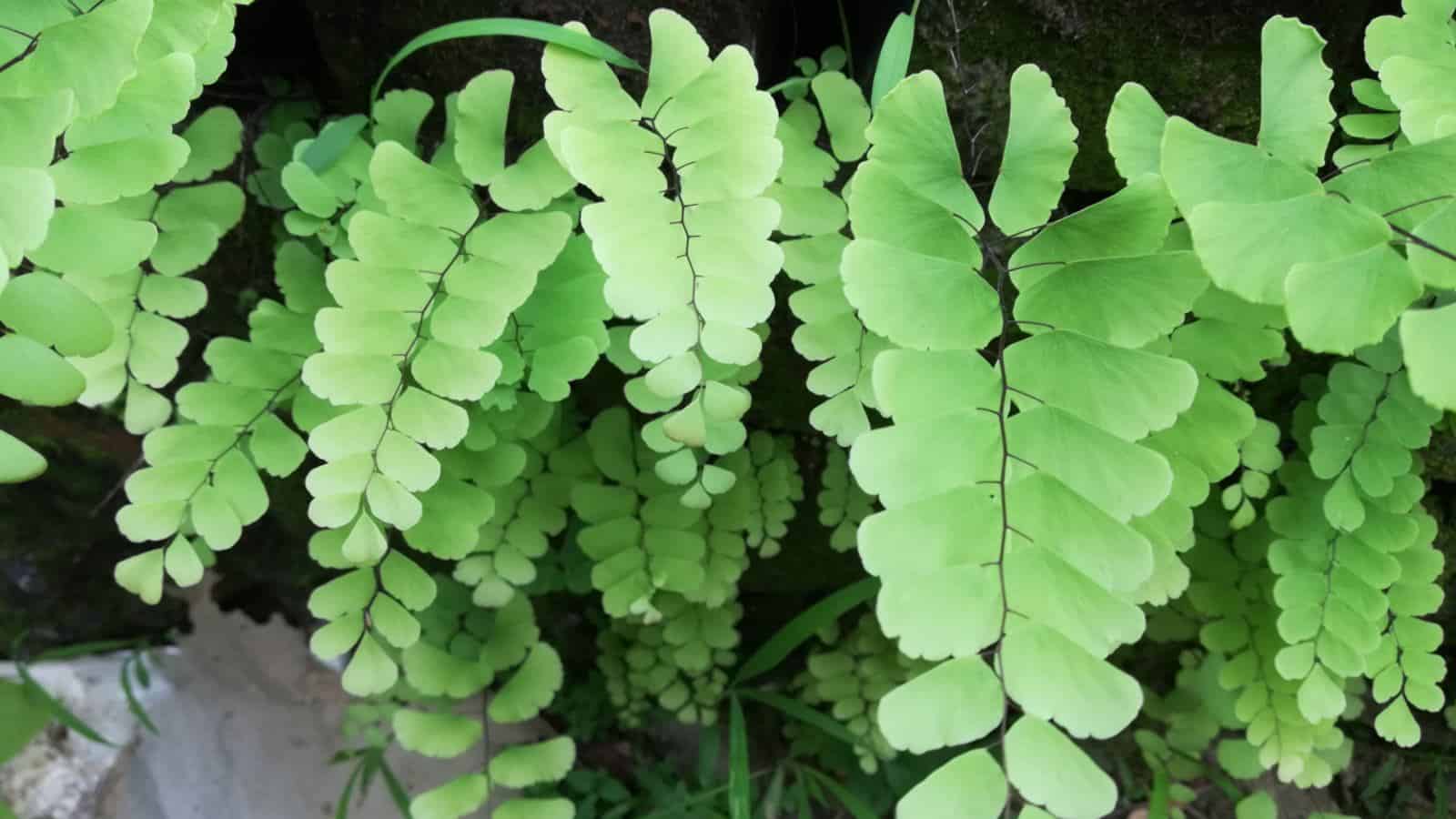
Southern Maidenhair Fern, scientifically known as Adiantum capillus-veneris, showcases the delicate beauty distinct to Maidenhair ferns. The dainty fan-shaped leaf segments, connected by wiry black stems, add elegance to your houseplant collection.
This type thrives in indirect or dappled light – too harsh sunlight could damage its tender foliage. It prefers warmth and humidity, making it a perfect addition to well-lit bathrooms or kitchens where steam can create optimal growing conditions.
A caveat for potential growers: never let this fern dry out completely! Its soil needs constant moisture yet must provide good drainage to avoid root rot issues; maintaining a careful watering balance is essential for healthy growth with Southern Maidenhair Ferns.
4 Common Signs of Pests in Maidenhair Ferns
Caring for Maidenhair Ferns can be challenging due to common issues like brown or yellow leaves, falling foliage, and leaf curling. Pests such as aphids, scale, mites, mealy bugs, and snails pose risks too.
But don’t worry! I’ll guide you through identifying these problems early on and suggest practical solutions.
-
Brown Leaves
Brown leaves often signal challenges with my maidenhair ferns. Watering issues, such as overwatering or underwatering, commonly lead to this discoloration. These fragile ferns also react negatively to harsh sunlight and cold drafts by turning their leaves brown.
More alarming causes can include pest infestations from mealybugs or scale insects that feed on the plant, resulting in a browning of the leaf surface. Even sinister fungal diseases like leaf spot or root rot can trigger a wave of brown among the otherwise lush green foliage.
-
Yellow Leaves
Yellow leaves in maidenhair ferns demand immediate attention. Overwatering is a common cause for this issue, as it leads to the yellowing and, eventually, browning of the delicate fronds.
It would be best to strike a balance – hydrate enough to keep the soil moist but not oversaturated.
Another culprit behind yellow leaves could be an unfavorable environment. Maidenhair ferns obsess over humid conditions; anything less can prompt discoloration or drying out of their lovely green foliage.
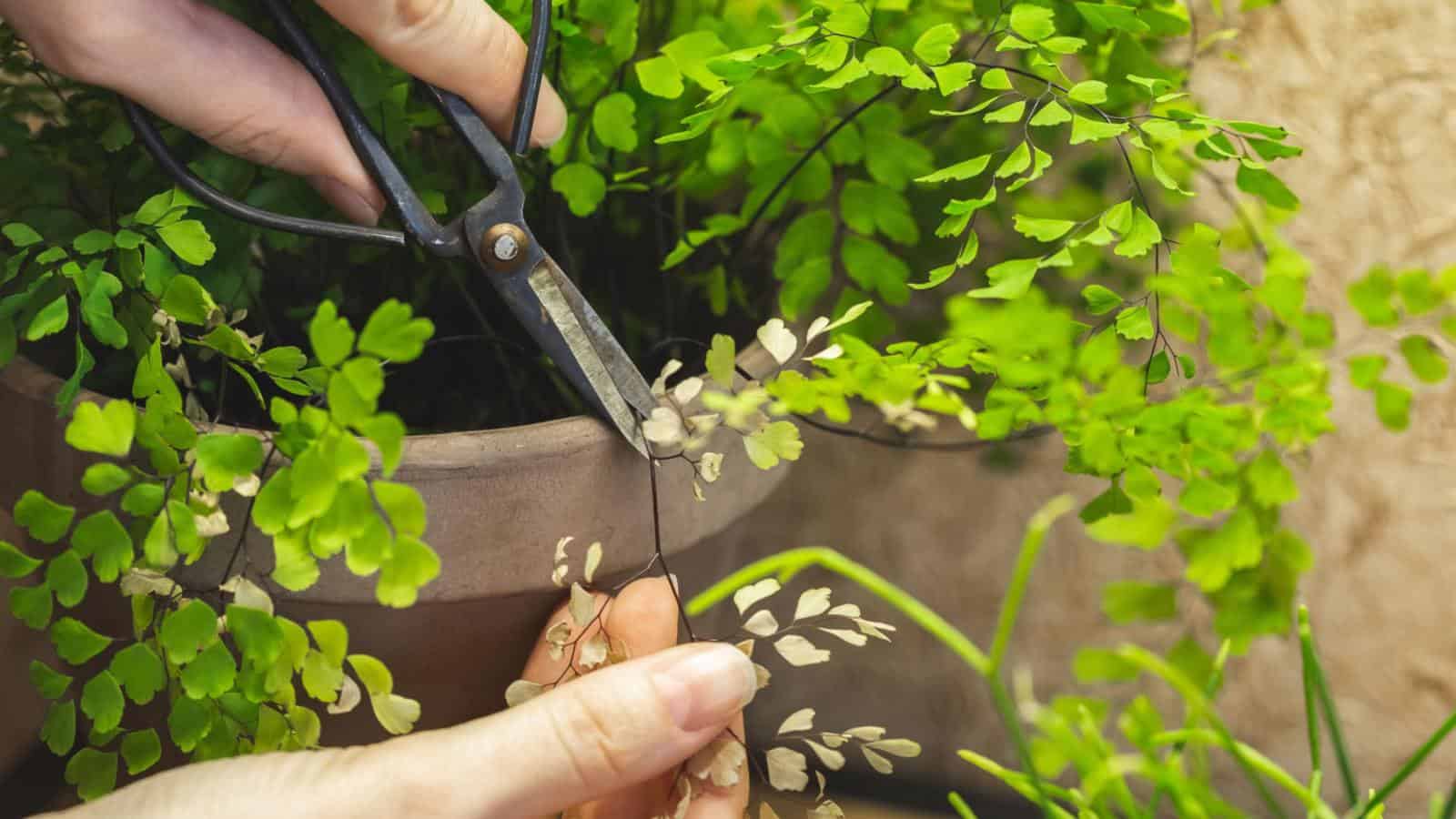
Too much or too little light also stirs up trouble, leading my plant into stress, which manifests as yellow leaves. Lastly, if signs point towards nutrient deficiencies evident through prolonged yellow fronds, introducing a balanced fertilizer blend during the growing season might save my fern from distress!
-
Falling Leaves
I’ve often noticed that my maidenhair ferns have a problem with falling leaves. If you’re seeing this too, it’s typically due to underwatering or the plant not getting enough humidity.
To fix this issue, increase your watering schedule and mist the leaves daily for added moisture. Furthermore, placing your fern in a bathroom can provide extra humidity from shower steam, which helps prevent leaf drop.
An indoor humidifier close to your plants works wonders as well! Sometimes, I use pebble trays filled with water underneath their pots; it creates a pleasant microclimate around them. Be vigilant about these strategies if falling leaves are ruining the lush appeal of your Adiantum raddianum.
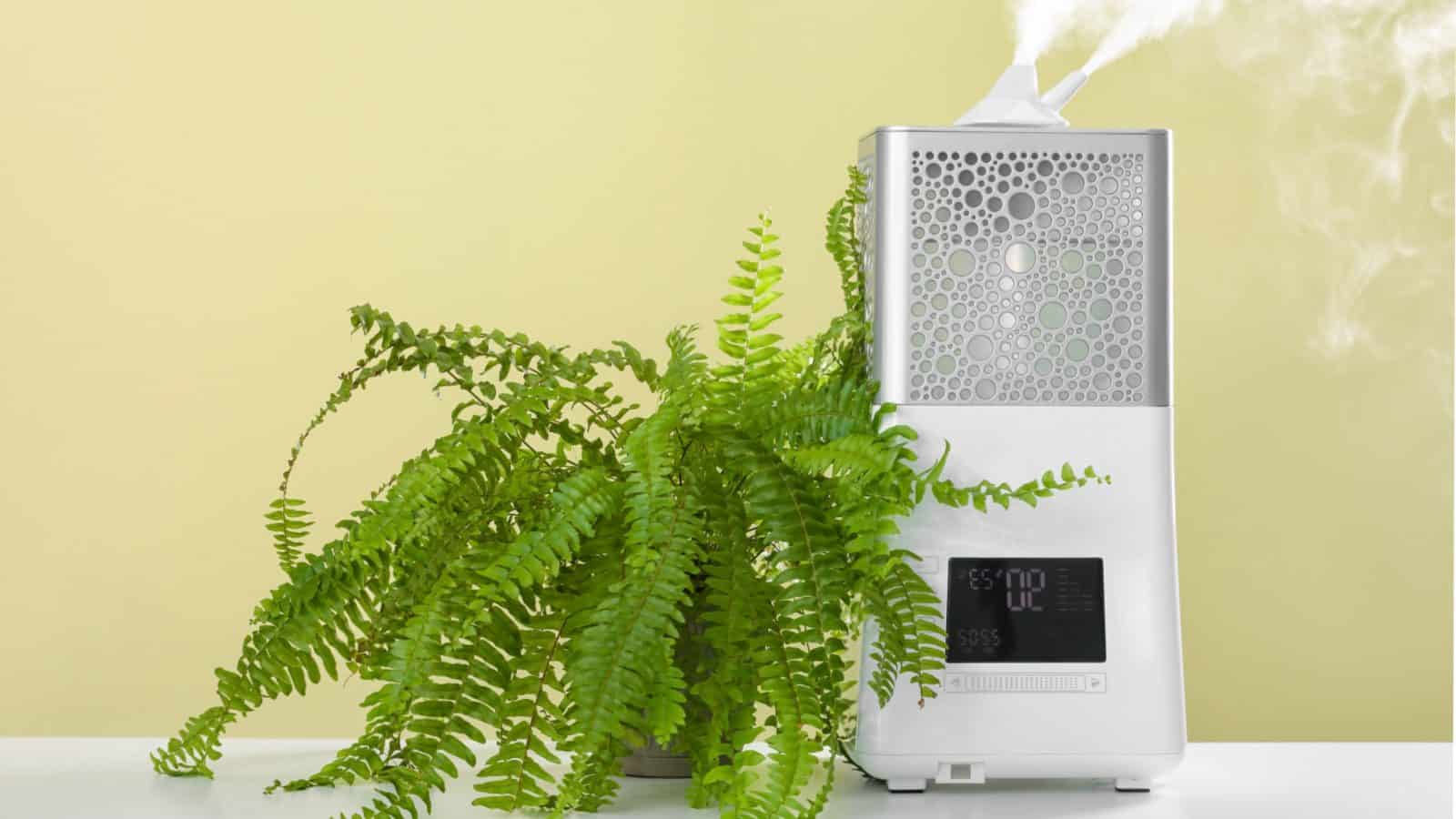
-
Curling Leaves
Curling Fern leaves give a signal that the plant requires attention and care. The issue may be due to too much direct sunlight or insufficient moisture around your Maidenhair Fern.
Missteps in watering habits, like over-saturation or insufficient, can also lead to this condition. Tiny pests such as aphids and spider mites can cause damage, leading to leaf curling.
Another potential reason is environmental stressors – variations in humidity levels or temperature shifts might prompt fern leaves into a curled position.
FAQs
How often should I water my Maidenhair fern?
Water your Maidenhair fern when the top inch of soil feels dry. Maintaining consistently moist soil but avoiding overwatering is crucial, which can lead to root rot.
Can I grow Maidenhair ferns indoors?
Yes, Maidenhair ferns are excellent indoor plants if they receive indirect light, high humidity, and consistent care. They can thrive in shaded areas or well-lit rooms away from direct sunlight.
What is the best soil mix for Maidenhair ferns?
Use a well-draining potting mix rich in organic matter, such as peat moss or coconut coir, to ensure proper soil moisture retention while preventing waterlogged roots.
How do I propagate Maidenhair ferns?
You can propagate Maidenhair ferns by dividing established plants at the rhizomes during the growing season. Ensure each division has both roots and fronds for successful propagation. They produce new growth and are essential for the fern’s survival.
Are Maidenhair ferns safe for pets?
Maidenhair ferns are generally non-toxic to pets but can still cause mild gastrointestinal upset if ingested. It’s best to keep them out of reach of curious pets to avoid any potential issues.
Conclusion
Caring for maidenhair ferns is truly a rewarding experience. As you nurture these slow-growing yet stunning plants, their intricate fronds flourish, enchanting your indoor garden.
With the proper knowledge and consistent care practices outlined in this guide, you are well on your way to successfully growing these feather-like beauties. Continue tending to them as they add charm and freshness to your indoor ambiance.
Other Fern Guides from Planet Natural:

